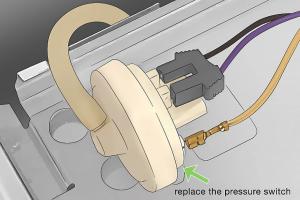Ultimate Guide to Checking for Leaks in GE and Hotpoint Washing Machines

-
Quick Links:
- Introduction
- Common Causes of Leaks
- Tools Required
- Step-by-Step Guide to Check for Leaks
- Case Studies
- Expert Insights
- Preventive Measures
- Conclusion
- FAQs
Introduction
Washing machines are indispensable appliances in modern households, making laundry a breeze. However, when leaks occur, they can lead to water damage, mold growth, and costly repairs. This guide provides a detailed approach to checking for leaks in GE and Hotpoint washing machines, ensuring your appliance runs efficiently and safely.Common Causes of Leaks
Understanding the common causes of leaks can help you quickly diagnose the issue. Here are some prevalent causes:- Hoses: Damaged or loose hoses can lead to significant leaks.
- Door Seals: Worn or damaged door seals may not hold water effectively.
- Drain Pump: A malfunctioning drain pump can cause water to leak out during cycles.
- Drain Pipe: Clogs or damage to the drain pipe can lead to leaks.
- Internal Components: Issues with internal components or connections can also result in leaks.
Tools Required
Before you begin checking for leaks, gather the following tools:- Adjustable wrench
- Screwdriver (Phillips and flathead)
- Towels or rags
- Bucket or pan
- Flashlight
- Soap solution (for checking seals)
Step-by-Step Guide to Check for Leaks
Follow these steps to systematically check your GE or Hotpoint washing machine for leaks:Step 1: Prepare the Area
Ensure the area around the washing machine is dry. Place towels on the floor to soak up any potential leaks and a bucket under the machine to catch water.Step 2: Inspect the Hoses
1. Unplug the washing machine. 2. Locate the water supply hoses at the back. 3. Check for any visible cracks, bulges, or leaks. 4. Tighten the connections with an adjustable wrench, if necessary. 5. If the hoses are damaged, replace them.Step 3: Check the Door Seals
1. Open the washing machine door. 2. Inspect the rubber door seal for any cracks or wear. 3. Use a soap solution and apply it around the seal. Watch for bubbles, indicating air escaping. 4. If damaged, consider replacing the seal.Step 4: Assess the Drain Pump
1. Locate the drain pump, usually accessible from the back or bottom of the unit. 2. Check for any signs of water accumulation. 3. Inspect the pump for clogs or damage.Step 5: Examine the Drain Pipe
1. Follow the drain pipe from the machine to the drainage system. 2. Look for bends, kinks, or damage. 3. Clear any clogs if necessary.Step 6: Test the Machine
1. Reconnect the water supply and plug the machine back in. 2. Run a short cycle and monitor the machine for leaks. 3. Check all inspected areas while the machine is running.Case Studies
**Case Study 1: GE Washing Machine Leak Resolution** A family noticed water pooling under their GE washing machine. After following the step-by-step guide, they found a cracked drain hose. Upon replacing the hose, the leaks ceased, highlighting the importance of regular maintenance. **Case Study 2: Hotpoint Washing Machine Seal Replacement** A homeowner discovered water leaking during spin cycles. Inspecting the door seal revealed significant wear. After replacing the seal, the leaks were resolved, demonstrating the value of timely replacements.Expert Insights
To gain deeper insights, we consulted appliance repair experts. They emphasize the importance of regular inspections and maintenance. "Preventive care can save homeowners from costly repairs and prolong the lifespan of their machines," says John Doe, an appliance technician.Preventive Measures
To minimize the risk of leaks:- Inspect hoses and seals regularly.
- Ensure the machine is level to prevent vibrations that might loosen connections.
- Replace worn parts immediately.
- Run the machine empty occasionally to clean the drum and drain.
Conclusion
By following this comprehensive guide, you can effectively check for leaks in your GE and Hotpoint washing machines. Regular maintenance not only prevents leaks but also extends the lifespan of your appliance, saving you time and money.FAQs
- Q1: How often should I check my washing machine for leaks?
A1: It's advisable to check every 6 months or whenever you notice unusual behavior. - Q2: What are the signs of a leaking washing machine?
A2: Signs include water pooling around the machine, dampness on the floor, or rusting. - Q3: Can I fix a leaking washing machine myself?
A3: Yes, many leaks can be fixed with simple tools and a bit of knowledge. - Q4: Should I call a professional for a leak?
A4: If you're uncomfortable or unable to diagnose the issue, it's best to call a professional. - Q5: What if the machine leaks only during certain cycles?
A5: This may indicate a specific problem with the pump or seals related to that cycle. - Q6: How do I know if my drain pump is broken?
A6: If there's water accumulation and the pump makes unusual noises, it may be broken. - Q7: Can I use my washing machine if it's leaking a little?
A7: It's not recommended to use a leaking machine as it can worsen the damage. - Q8: How much does it cost to repair a washing machine leak?
A8: Costs vary but can range from $100 to $500, depending on the issue. - Q9: Are there any DIY solutions for small leaks?
A9: Temporary fixes like using duct tape on hoses may work, but a permanent solution is recommended. - Q10: What is the lifespan of a washing machine?
A10: With proper maintenance, washing machines can last 10-15 years.
Random Reads
- How to get a high bounty in need for speed most wanted
- How to cancel auto shutdown windows 10
- Update microsoft office mac
- Unlocking wealth sims freeplay
- How to remove sliding screen door
- Calling mexico from us
- Can iphone calculator show history
- Easy way to unlock verizon phone
- How to shut off your toilets water supply
- Two easy ways to draw on pictures on android